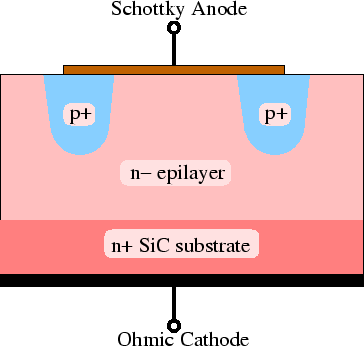Materials, Reliability and Failure Analysis
Tuyen D. Le May 11, 2022 [Power-Electronics] #MaterialsKinetic thermal energy $$ K_{kin} = \frac{m}{2}v_{th}^2 = \frac{3}{2}kT $$
When an electric field $E$ is applied, each carrier (i.e. electrons and holes) experiences a force $± q \times E$ and is accelerated. These velocities caused by the external electrical field $E$ are called drift velocities 1.
The current density $J$, or the current flow of electrons per unit volume, is given by the following:
$$ \begin{align*} J_n &= nqv_d \newline J_n &= nq\dfrac{1}{2} \dfrac{q\tau}{m^{2}}E \end{align*} $$
Electron mobility $\mu_n$ is the ratio of drift velocity to the electric field strength.
$$ \mu_n = \dfrac{\nu_d}{E} = \dfrac{q \tau}{m^*} $$
Hight voltage Shottky diode
- Anisotropic: Sic, GaN. Mobility are different in parallel $\mu_{\parallel}$ and perpendicular $\mu_{\perp}$ direction.
- Phonons: lattice vibration
- Scattering: small amount of things spread over an area.
- More dopping --> more phonons --> $\mu_{n} \downarrow$ and desisty $\downarrow$. However, in combination with thickness and doping density --> Wide Bandgap semiconductors have lower conduction losses.
- Shottky diode: $E_{max}$ at the contact semiconductor and metal or P-N junction.
- Merged PiN Schottky Diodes (MPS) structure: reduce electrical field stress
- "Trench Oxide Pin Schottky" (TOPS): reduce contact between metal and semiconductor --> prevent the migration of carriers at the anode (metal). The rest of structure is the same as MPS 2.
- Soft recovery. Soft factor $s = \cfrac{t_f}{t_s} \gt 0.8$
 | |
| Cross section of a merged pin Schottky diode in SiC 3 |
References
Lutz, J., Schlangenotto, H., Scheuermann, U. and De Doncker, R., 2011. Semiconductor power devices. Physics, characteristics, reliability, 2.